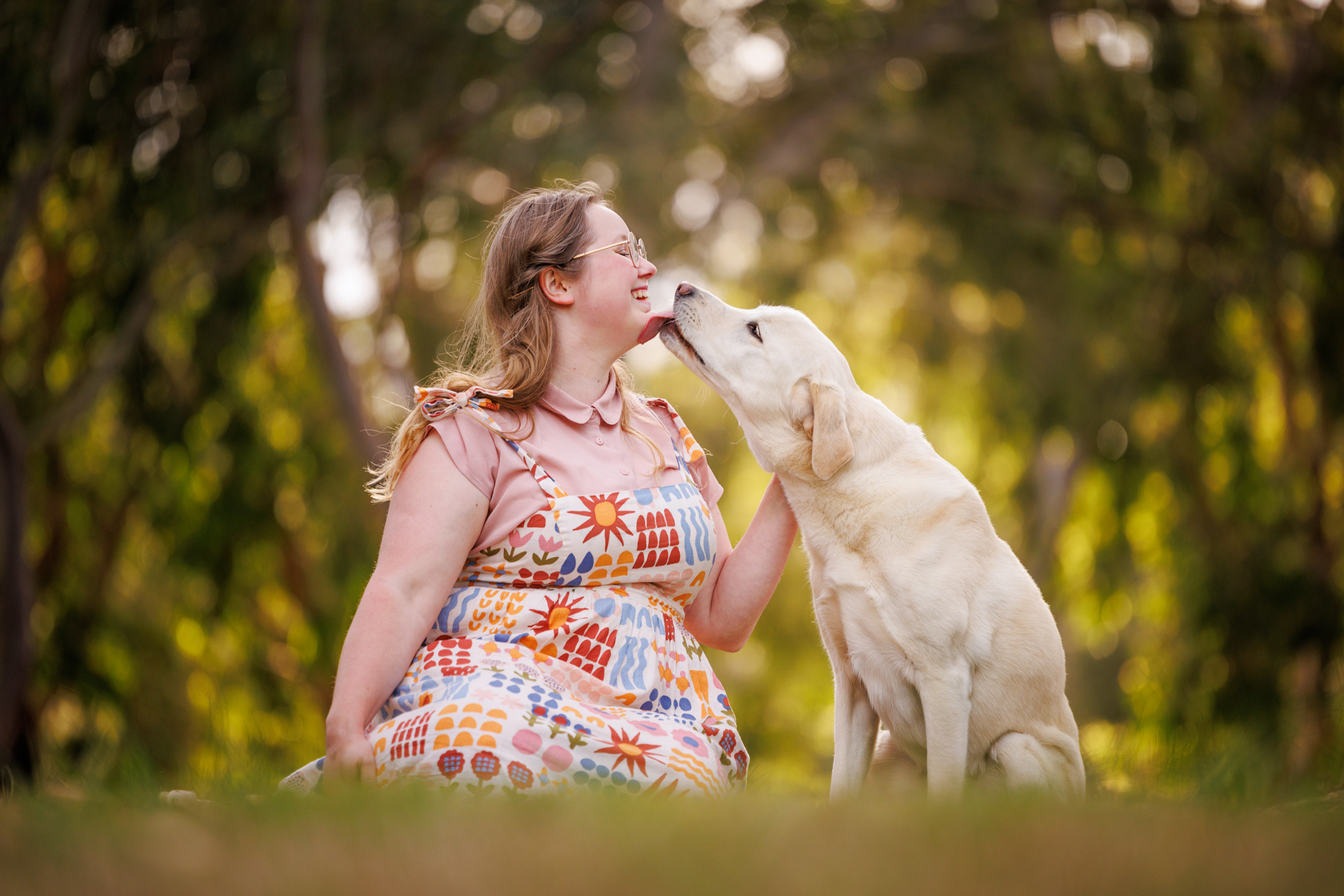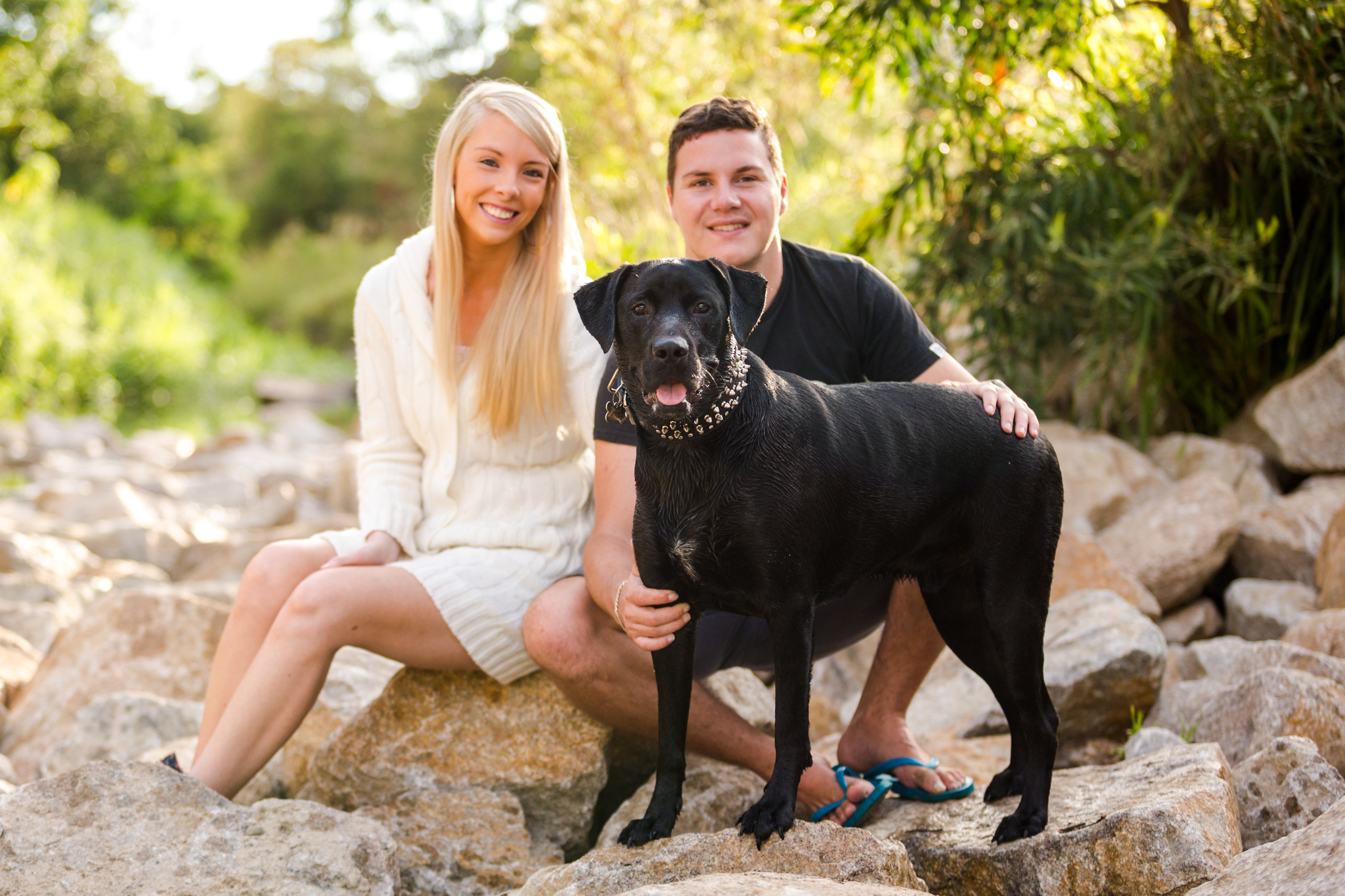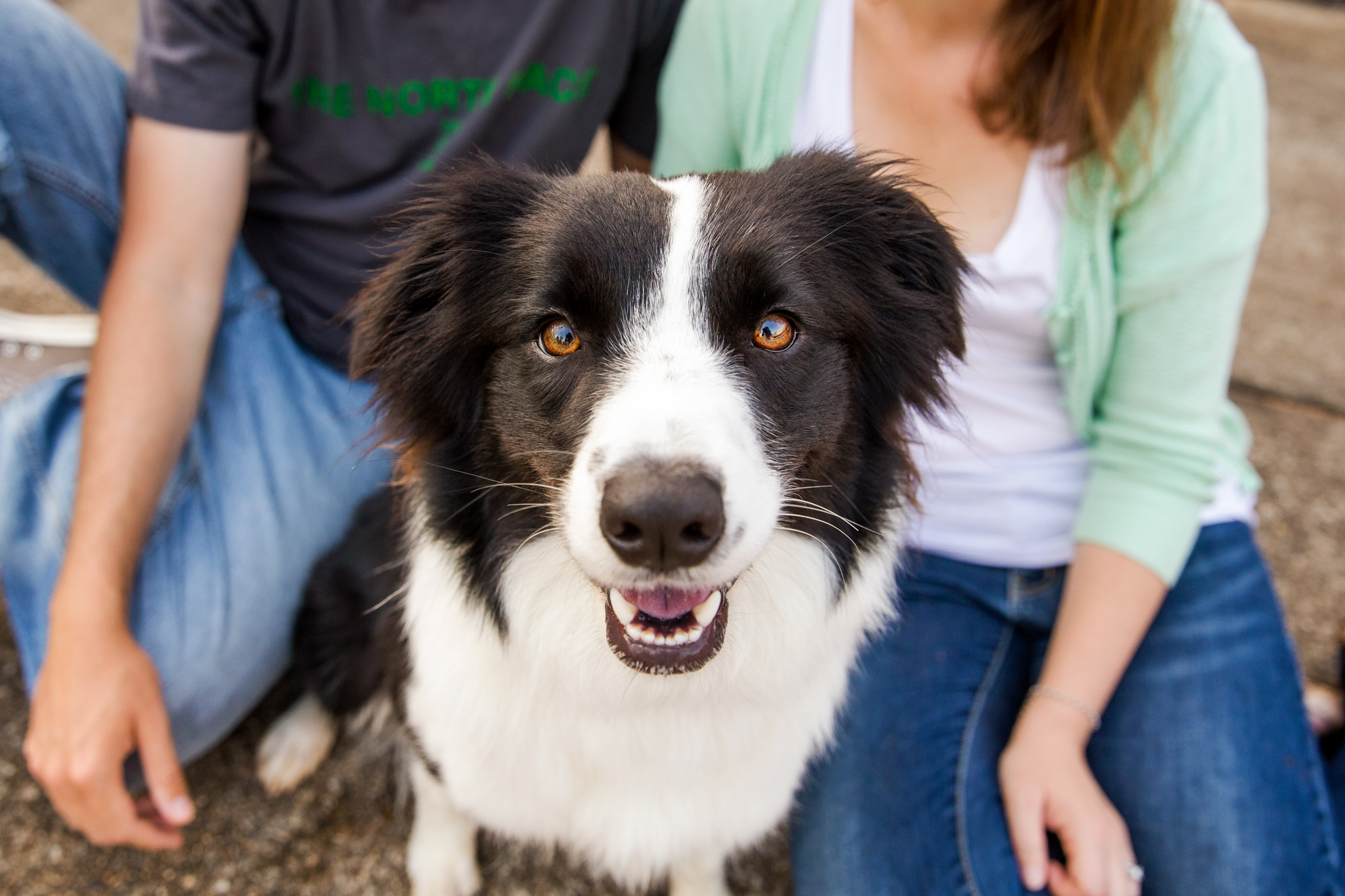12 Tips for Working with Pets and their People
Aug 19, 2017
By Charlotte Reeves
Often we specialise in pet photography because we relate to animals better than people, am-I-right? There will inevitably come a time when you do need to photograph your furry subject's humans though. Knowing what to say, how to pose (and when not to) and what settings to use is vital info that you won't find anywhere else.
1. Owner Interactions
When including owners in the shot, put them at ease by asking them to interact with their dog. My favourite dog and owner images are natural, candid captures of belly rubs, kisses and paw shakes.
Rather than asking people to look at the camera and smile (a great way of getting that stunned mullet expression 🐟) this is a much better method of easing into dog and owner photos during a session. Interacting with their dogs gets people relaxed and often laughing at their dog's funny and cute antics - and we all know laughter makes the best smiles!

Canon 1D-X Mark II, Canon EF 70-200mm ƒ/2.8L IS II @ 160mm, ISO 1600, 1/800 sec, ƒ/2.8
2. Lap dog pose
An alternative pose for dogs and owners, putting little dogs on laps can sometimes help to keep them calm and still. People don’t always like their faces to feature in photos, but are happy for their body to be out of focus in the background. This is a good way of keeping both dog and owner happy!

Canon EOS 1D X Mark II, Canon EF 24-70mm f/2.8L II @ 35mm, ISO 1600, 1/640 sec, f/2.8
3. Ask the question
In my pre-session questionnaire, I ask if people wish to be in some of the photos with their pets. I make it pretty clear I’m not a family photographer, but I always invite people to jump in for a few shots but make it clear their pets will be the focus of the images.
The exact question I ask is: “Would you like to be in some photos?” and the multiple choice answers are:
1. Definitely do not want to appear in any photos
2. Would be happy to appear in the background or not as the main focus of the photos
3. Would like you to capture some candid moments with my pets
4. Would like a few posed portraits of me and my pets
Sometimes people even choose a couple of options - which is super helpful! This gives me an idea before the session of what to expect, and when I meet them I can start thinking about how best to incorporate them into some shots with their pets. I always check with them on the day too, just in case they’ve changed their mind since they completed the questionnaire!
Can anyone guess which category from the four options this image falls into?

Canon EOS 1D X, Canon EF 24-70mm f/2.8L II @ 38mm, ISO 1600, 1/500 sec, f/2.8
4. Get down to their level
Getting down to the level of the dog applies when both photographing just the dog, as well as when photographing the dog with the owner, especially when the dog is too big to be picked up.
I often just ask people to look at their dog while I am photographing them, even if they’ve specifically asked for “posed portraits” as this often encourages more interaction and natural expressions.

Canon EOS R5, Canon RF 70-200mm ƒ/2.8L IS @ 200mm, ISO 400, 1/1000 sec, ƒ/2.8
5. Give them space
When working with dogs that are fearful with new people but have a solid, trusting relationship with their owners, capturing “dog and owner” shots while hanging back and zooming in with a long lens can be a great way to give the dog some much-needed space.
It’s actually a good piece of advice for working with fearful dogs in general, but often having their owner close by can help them relax even more and encourages them to exhibit the kinds of behaviour and expressions their owner is used to seeing at home.

Canon EOS 1D X Mark II, Canon EF 135mm ƒ/2L, ISO 160, 1/500 sec, f/2
6. Perfectly framed
Especially when shooting in urban areas, use your surroundings to frame and feature dog and owner relationships. This beautiful church doorway creates the perfect frame for Hugo the Great Dane and his mum Sarah, and their elegant poses help to accentuate that classy feel. Finally, the connection between them created through touch and line of sight finish the shot beautifully.

Canon EOS 5D Mark II, Canon EF 70-200mm f/2.8L @ 75mm, ISO 1600, 1/500 sec, f/2.8
7. Capture genuine moments
I can’t emphasise enough, how important it is with pets and people to capture natural interactions, expressions and poses. Asking people to pose and micro-managing where their hands or arms are, or where exactly they are looking, often ends up in fake, awkward looking poses and non-genuine expressions.
The best thing you can do is pick a spot that has pretty lighting, a nice background, then ask people to sit there with their pet. Tell them they don’t need to look at the camera, in fact, no need to even face the camera! And to just talk to their dog, ask for kisses, perhaps keep them engaged with treats - anything to encourage interaction.
And often, you end up with just that. Genuine, real interactions that really capture their relationship. Just beautiful!

Canon EOS 1D X, Canon EF 70-200mm f/2.8L @ 140mm, ISO 500, 1/800 sec, f/2.8
8. Walk up and back
Shooting from a long way back and zooming in with a telephoto lens is a great way to include the surroundings, while reducing the pressure on people to “pose”. I often send them off for a walk - saying to walk up to a certain point and then walk back again towards me - and I just hang back and snap candids as they’re walking.
People often forget I am there and act naturally, talking and laughing with each other privately, while their dogs just hang out with them. The “walk up and back” is a great technique to use for capturing candids!

Canon EOS 1D X, Canon EF 70-200mm f/2.8L @ 200mm, ISO 640, 1/1250 sec, f/2.8
9. Focus on the dog
As a pet photographer, if you have to choose, your focus should always be on the dog!
While getting all the subjects on the same plane of focus is great for some shots, sometimes you might like to do a little storytelling by having the dog out in front and the human subjects out of focus in the background.

Canon EOS 1D X, Canon EF 70-200mm f/2.8L @ 73mm, ISO 500, 1/800 sec, f/2.8
10. Switch to wide
If you’re finished taking a group shot with a long lens to capture natural interactions, ask them to stay where they are while you switch to a wide lens and get up closer.
While it’s nearly impossible to get everyone in the group in focus up close with a wide angle lens and a big aperture, embrace the shallow depth of field, focusing on just one group member, with the others in the background out of focus. Move around and do this with each group member in turn, to create a collection of alternative family portraits, great for extra shots for an album.

Canon EOS 1D X, Canon EF 24-70mm f/2.8L II @ 28mm, ISO 1000, 1/640 sec, f/4
11. Space out your subjects
Silhouettes are one of my favourite ways to incorporate owners into the session, without placing too much pressure on them. I like to explain to them that silhouettes will only show their outline - they’ll be completely black in the image - so this takes the pressure off them somewhat as many people hate being in front of the camera as they feel pressured to smile or look a certain way!
With silhouettes, ensure the owners and dogs are not standing in front of each other. Space them out so that clear sky can be seen all around their outlines. Also, try to position the dogs so they are side-on to the camera and looking to the side as well, so their side profiles can be seen rather than just a head blob with ears!
It should be possible to pick the breeds of these two dogs, without even seeing their colours or features. What do you think their breeds are?

Canon EOS 5D Mark II, Canon EF 70-200mm f/2.8L @ 155mm, ISO 400, 1/800 sec, f/2.8
12. Owner Detail Shots
When shooting for a client and they’ve indicated they’d like to be involved in some of the photos, but aren’t a fan of photos of themselves, find creative ways to incorporate them without focusing on their face or making them pose awkwardly. One way to is focus on other body parts such as hands, showing their relationship through how they interact with their dog.

Canon EOS 1D X, Canon EOS 70-200mm f/2.8L @ 140mm, ISO 800, 1/500 sec, f/5
Join our mailing list!
Want to improve your pet photography with free tips and expert advice?
Join our mailing list and get a guided tour of what we have to offer, along with our weekly newsletter packed with practical pet photography insights.
📩 Sign up now and start learning with us!
We hate SPAM. We will never sell your information, for any reason.

